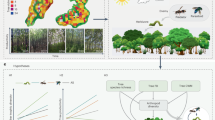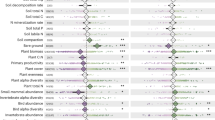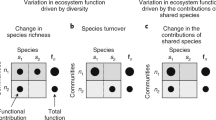Abstract
Numerous studies have demonstrated that plant species diversity enhances ecosystem functioning in terrestrial ecosystems, including diversity effects on insects (herbivores, predators and parasitoids) and plants. However, the effects of increased plant diversity across trophic levels in different ecosystems and biomes have not yet been explored on a global scale. Through a global meta-analysis of 2,914 observations from 351 studies, we found that increased plant species richness reduced herbivore abundance and damage but increased predator and parasitoid abundance, predation, parasitism and overall plant performance. Moreover, increased predator/parasitoid performance was correlated with reduced herbivore abundance and enhanced plant performance. We conclude that increasing plant species diversity promotes beneficial trophic interactions between insects and plants, ultimately contributing to increased ecosystem services.
This is a preview of subscription content, access via your institution
Access options
Access Nature and 54 other Nature Portfolio journals
Get Nature+, our best-value online-access subscription
$29.99 / 30 days
cancel any time
Subscribe to this journal
Receive 12 digital issues and online access to articles
$119.00 per year
only $9.92 per issue
Buy this article
- Purchase on Springer Link
- Instant access to full article PDF
Prices may be subject to local taxes which are calculated during checkout




Similar content being viewed by others
Data availability
All data generated or analysed during this study are included in this Article and its Extended data, Supplementary tables and Supplementary methods.
References
Li, L., Tilman, D., Lambers, H. & Zhang, F. S. Plant diversity and overyielding: insights from belowground facilitation of intercropping in agriculture. New Phytol. 203, 63–69 (2014).
Tilman, D., Reich, P. B. & Knops, J. M. Biodiversity and ecosystem stability in a decade-long grassland experiment. Nature 441, 629–632 (2006).
Isbell, F. et al. Benefits of increasing plant diversity in sustainable agroecosystems. J. Ecol. 105, 871–879 (2017).
Huang, Y. et al. Impacts of species richness on productivity in a large-scale subtropical forest experiment. Science 362, 80–83 (2018).
Cardinale, B. J., Ives, A. R. & Inchausti, P. Effects of species diversity on the primary productivity of ecosystems: extending our spatial and temporal scales of inference. Oikos 104, 437–450 (2010).
Bright, M. B. H. et al. Long-term Piliostigma reticulatum intercropping in the Sahel: crop productivity, carbon sequestration, nutrient cycling, and soil quality. Agric. Ecosyst. Environ. 242, 9–22 (2017).
Damien, M. et al. Flowering crops in winter increases pest control but not trophic link diversity. Agric. Ecosyst. Environ. 247, 418–425 (2017).
Wan, N. F. et al. Increasing plant diversity with border crops reduces insecticide use and increases crop yield in urban agriculture. eLife 7, e35103 (2018).
Macfadyen, S. et al. Do differences in food web structure between organic and conventional farms affect the ecosystem service of pest control? Ecol. Lett. 12, 229–238 (2009).
Dainese, M. et al. A global synthesis reveals biodiversity-mediated benefits for crop production. Sci. Adv. 5, eaax0121 (2019).
Loreau, M. & Hector, A. Partitioning selection and complementarity in biodiversity experiments. Nature 412, 72–76 (2001).
Frank, K. T., Petrie, B., Choi, J. S. & Leggett, W. C. Trophic cascades in a formerly cod-dominated ecosystem. Science 308, 1621–1623 (2005).
Knight, T. M., Mccoy, M. W., Chase, J. M., McCoy, K. A. & Holt, R. D. Trophic cascades across ecosystems. Nature 437, 880–883 (2005).
Start, D. & Gilbert, B. Predator personality structures prey communities and trophic cascades. Ecol. Lett. 20, 366–374 (2017).
Scherber, C. et al. Bottom-up effects of plant diversity on multitrophic interactions in a biodiversity experiment. Nature 468, 553–556 (2010).
Ebeling, A. et al. Plant diversity effects on arthropods and arthropod-dependent ecosystem functions in a biodiversity experiment. Basic Appl. Ecol. 26, 50–63 (2018).
Bischoff, A. et al. Effects of spontaneous field margin vegetation and surrounding landscape on Brassica oleracea crop herbivory. Agric. Ecosyst. Environ. 223, 135–143 (2016).
Wan, N. F. et al. Plant diversification promotes biocontrol services in peach orchards by shaping the ecological niches of insect herbivores and their natural enemies. Ecol. Indic. 99, 387–392 (2019).
Hector, A. et al. Plant diversity and productivity experiments in European grasslands. Science 286, 1123–1127 (1999).
Seabloom, E. W. et al. Food webs obscure the strength of plant diversity effects on primary productivity. Ecol. Lett. 20, 505–512 (2017).
Litsinger, J. A., Hasse, V., Barrion, A. T. & Schmutterer, H. Response of Ostrinia furnacalis (Guenée) (Lepidoptera: Pyralidae) to intercropping. Environ. Entomol. 20, 988–1004 (1991).
Hooks, C. R. R. & Johnson, M. W. Lepidopteran pest populations and crop yields in row intercropped broccoli. Agric. Forest Entomol. 4, 117–125 (2002).
Nitschke, N. et al. Plant diversity has contrasting effects on herbivore and parasitoid abundance in Centaurea jacea flower heads. Ecol. Evol. 7, 9319–9332 (2017).
Moreira, X. et al. Plant diversity effects on insect herbivores and their natural enemies: current thinking, recent findings, and future directions. Curr. Opin. Insect Sci. 14, 1–7 (2016).
Gurevitch, J., Koricheva, J., Nakagawa, S. & Stewart, G. Meta-analysis and the science of research synthesis. Nature 555, 175–182 (2018).
Chaplin-Kramer, R., O’Rourke, M. E., Blitzer, E. J. & Kremen, C. A meta-analysis of crop pest and natural enemy response to landscape complexity. Ecol. Lett. 14, 922–932 (2011).
Shackelford, G. et al. Comparison of pollinators and natural enemies: a meta-analysis of landscape and local effects on abundance and richness in crops. Biol. Rev. 88, 1002–1021 (2013).
Letourneau, D. K. et al. Does plant diversity benefit agroecosystems? A synthetic review. Ecol. Appl. 21, 9–21 (2011).
Dassou, A. G. & Tixier, P. Response of pest control by generalist predators to local-scale plant diversity: a meta-analysis. Ecol. Evol. 6, 1143–1153 (2016).
Greenstone, M. H., Cornelius, M. L., Olsen, R. T. & Payton, M. E. Test of a natural enemy hypothesis on plant provenance: spider abundance in native and exotic ornamental landscapes. J. Entomol. Sci. 52, 340–351 (2017).
Novais, S. M. A., Macedo-Reis, L. E. & Neves, F. S. Predatory beetles in cacao agroforestry systems in Brazilian Atlantic forest: a test of the natural enemy hypothesis. Agroforestry Syst. 91, 201–209 (2017).
Root, R. B. Organization of a plant–arthropod association in simple and diverse habitats: the fauna of collards (Brassica oleracea). Ecol. Monogr. 43, 95–124 (1973).
Long, Z. T., Mohler, C. L. & Carson, W. P. Extending the resource concentration hypothesis to plant communities: effects of litter and herbivores. Ecology 84, 652–665 (2003).
Ebeling, A., Klein, A. M., Schumacher, J., Weisser, W. W. & Tscharntke, T. How does plant richness affect pollinator richness and temporal stability of flower visits? Oikos 117, 1808–1815 (2008).
Ebeling, A. et al. Plant diversity impacts decomposition and herbivory via changes in aboveground arthropods. PLoS ONE 9, e106529 (2014).
Bernays, E. A., Bright, K. L., Gonzalez, N. & Angel, J. Dietary mixing in a generalist herbivore: tests of two hypotheses. Ecology 75, 1997–2006 (1994).
Srivastava, D. S. & Lawton, J. H. Why more productive sites have more species: an experimental test of theory using tree-hole communities. Am. Nat. 152, 510–529 (1998).
Janssen, A., Sabelis, M. W., Magalhães, S., Montserrat, M. & Van der Hammen, T. Habitat structure affects intraguild predation. Ecology 88, 2713–2719 (2007).
Coll, M. & Bottrell, D. G. Effects of nonhost plant on an insect herbivore in diverse habitats. Ecology 75, 723–731 (1994).
Petermann, J. S., Müller, C. B., Weigelt, A., Weisser, W. W. & Schmid, B. Effect of plant species loss on aphid–parasitoid communities. J. Anim. Ecol. 79, 709–720 (2010).
Karp, D. S. et al. Crop pests and predators exhibit inconsistent responses to surrounding landscape composition. Proc. Natl Acad. Sci. USA 115, 7863–7870 (2018).
Martin, E. A. et al. The interplay of landscape composition and configuration: new pathways to manage functional biodiversity and agroecosystem services across Europe. Ecol. Lett. 22, 1047–1175 (2019).
Sirami, E. et al. Increasing crop heterogeneity enhances multitrophic diversity across agricultural regions. Proc. Natl Acad. Sci. USA 116, 16442–16447 (2019).
Lu, M. et al. Responses of ecosystem nitrogen cycle to nitrogen addition: a meta-analysis. New Phytol. 189, 1040–1050 (2011).
Treseder, K. K. Nitrogen additions and microbial biomass: a meta-analysis of ecosystem studies. Ecol. Lett. 11, 1111–1120 (2008).
Liu, L. L. & Greaver, T. L. A global perspective on belowground carbon dynamics under nitrogen enrichment. Ecol. Lett. 13, 819–828 (2010).
Liao, C. et al. Altered ecosystem carbon and nitrogen cycles by plant invasion: a meta-analysis. New Phytol. 177, 706–714 (2008).
Viechtbauer, W. Conducting meta-analyses in R with the metafor package. J. Stat. Softw. 36, 1–48 (2010).
Nakagawa, S. & Santos, E. S. Methodological issues and advances in biological meta-analysis. Evol. Ecol. 26, 1253–1274 (2012).
Shipley, B. Confirmatory path analysis in a generalized multilevel context. Ecology 90, 363–368 (2009).
Begg, C. B. & Mazumdar, M. Operating characteristics of a rank correlation test for publication bias. Biometrics 50, 1088–1101 (1994).
Duval, S. & Tweedie, R. Trim and fill: a simple funnel-plot–based method of testing and adjusting for publication bias in meta-analysis. Biometrics 56, 455–463 (2000).
Rosenberg, M. S. The file-drawer problem revisited: a general weighted method for calculating fail-safe numbers in meta-analysis. Evolution 59, 464–468 (2005).
R: A Language and Environment for Statistical Computing (R Foundation for Statistical Computing, 2018).
Lefcheck, J. S. piecewiseSEM: piecewise structural equation modeling in R for ecology, evolution, and systematics. Methods Ecol. Evol. 7, 573–579 (2015).
Pinheiro, J., Bates, D., DebRoy, S., Sarkar, D. & R Core Team nlme: Linear and nonlinear mixed effects models. R package version 3.1–137 https://CRAN.R-project.org/package=nlme (2018).
Acknowledgements
We thank M. van Kleunen, E. Siemann, X. Chen and Z.-W. Ren for useful suggestions on early versions of this paper, J. Weiner for providing the inspiration for this study, and all of the people whose data and work have been included in this meta-analysis. This study was financially supported by the Agriculture Research System of Shanghai, China (grant no. 201908), the National Natural Science Foundation of China (31401751 and 11971117), the Shanghai Academy of Agricultural Sciences Program for Excellent Research Team (2018[B-01]) and the European Union’s Horizon 2020 research and innovation programme (grant no. 727284).
Author information
Authors and Affiliations
Contributions
N.-F.W., X.-R.Z., J.-X.J., Y.-M.C. and B.L. conceived the idea. N.-F.W., X.-R.Z., Y.-M.C., J.-X.J. and B.L. collected the data. N.-F.W., M.D. and S.-Y.Q. made the maps. N.-F.W., X.-R.Z., L.-W.F., L.P.K., Z.Z., R.C.-K., M.D., J.T., S.-Y.Q., Y.-Q.H., W.-D.T., M.N., R.-T.J., J.-Y.D., J.-X.J., Y.-M.C. and B.L. analysed the data. N.-F.W., X.-R.Z., L.P.K., Z.Z., J.-X.J., Y.-M.C. and B.L. drafted the article. N.-F.W., X.-R.Z., L.-W.F., L.P.K., Z.Z., R.C.-K., M.D., J.T., J.-X.J., Y.-M.C. and B.L. wrote the manuscript. All authors prepared and edited the final drafts.
Corresponding authors
Ethics declarations
Competing interests
The authors declare no competing interests.
Additional information
Peer review information Nature Plants thanks Forest Isbell and the other, anonymous, reviewer(s) for their contribution to the peer review of this work.
Publisher’s note Springer Nature remains neutral with regard to jurisdictional claims in published maps and institutional affiliations.
Extended data
Extended Data Fig. 1 Mean effect sizes of 12 response categories for the 4 trophic groups in agroecosystems, grasslands and forests, separately.
Numbers in brackets indicate the numbers of observations and studies, respectively. The horizontal lines indicate the 95% confidence intervals around the means. Black, red, green, and blue lines represent predators, parasitoids, herbivores and plants, respectively.
Extended Data Fig. 2 Response of 12 response categories for 4 trophic groups to herbaceous and woody plants.
Numbers in brackets indicate the numbers of observations and studies, respectively. The horizontal lines indicate the 95% confidence intervals around the means. Black, red, green, and blue lines represent predators, parasitoids, herbivores and plants, respectively.
Extended Data Fig. 3 Response of 12 response categories for 4 trophic groups to tropical and temperate biomes.
Numbers in brackets indicate the numbers of observations and studies, respectively. The horizontal lines indicate the 95% confidence intervals around the means. Black, red, green, and blue lines represent predators, parasitoids, herbivores and plants, respectively.
Extended Data Fig. 4 Scatter plots showing the relationship between log-transformed number of added species in the plant species diversity treatment over the control and the effect sizes along with the fitted meta-regression line.
a, Scatter plot for predator performance (571 observations/122 studies). b, Scatter plot for parasitoid performance (135 observations/57 studies). c, Scatter plot for herbivore performance (947 observations/214 studies). d, Scatter plot for plant performance (1041 observations/161 studies). Predator performance included predator abundance and predation, parasitoid performance included parasitoid abundance and parasitism, herbivore performance was involved in herbivore abundance and herbivore damage and plant performance was related with plant growth, quality and reproduction. The dark and light shaded regions indicate respectively the 95% confidence interval for the predicted average SMD and the 95% credible/prediction interval. The regression model intercepts, slopes and the P-values for the slopes are presented.
Extended Data Fig. 5 Scatter plots showing the relationship between number of added plant species over control and effect sizes for predator, parasitoid, herbivore and plant performances.
a–d, Scatter plots for agroecosystems. e–h, Scatter plots for grasslands. i–l, Scatter plots for forests. Sample sizes for Fig. S5a-5l are 533, 124, 732, 541, 64, 29, 133, 391, 112, 7, 139 and 109, respectively. The fitted meta-regression lines are also presented. The dark shaded and the light shaded regions indicate the 95% confidence interval for the predicted average SMD and the 95% credible/prediction interval respectively. The regression model intercepts, slopes, and the P-values for the slopes are presented.
Supplementary information
Supplemental Information
Supplementary Tables 1–11, methods and references.
Rights and permissions
About this article
Cite this article
Wan, NF., Zheng, XR., Fu, LW. et al. Global synthesis of effects of plant species diversity on trophic groups and interactions. Nat. Plants 6, 503–510 (2020). https://doi.org/10.1038/s41477-020-0654-y
Received:
Accepted:
Published:
Issue Date:
DOI: https://doi.org/10.1038/s41477-020-0654-y
This article is cited by
-
Transnational conservation to anticipate future plant shifts in Europe
Nature Ecology & Evolution (2024)
-
Diversified cropping systems with complementary root growth strategies improve crop adaptation to and remediation of hostile soils
Plant and Soil (2024)
-
Multitrophic arthropod diversity mediates tree diversity effects on primary productivity
Nature Ecology & Evolution (2023)
-
Not invasive status but plant overstory matters: open shrub canopies support greater plant and arthropod diversity and more complex food web structures compared to shady tree canopies
Arthropod-Plant Interactions (2023)
-
Plant genetic diversity affects multiple trophic levels and trophic interactions
Nature Communications (2022)



